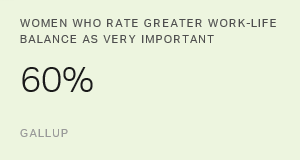This article is featured in "Women and the Workplace," a weeklong series exploring a variety of issues affecting modern working women.
PRINCETON, NJ -- When asked to rate 13 different aspects of their job and work environment, women employed full time in the U.S. differed most from their male counterparts in reaction to their pay. Twenty-eight percent of full-time working women are completely satisfied with their pay, compared with 34% of men.

Men and women have nearly identical reactions to the other 12 aspects of work measured -- or at least the differences (up to four percentage points) are not statistically significant. This includes differences in satisfaction with their chances for promotion, the amount of on-the-job stress they have, and the flexibility of their work hours. Accordingly, the rank order of issues according to satisfaction is similar between the genders, with physical safety at the top for both, and stress and the amount of money earned at the bottom.
These finding are based on 2,076 full-time workers interviewed as part of Gallup's annual Work and Education poll between 2010 and 2014, including 1,281 men and 795 women.
According to the full range of responses, 71% of women versus 76% of men are completely or somewhat satisfied with their earnings, while 29% of women and 23% of men are completely or somewhat dissatisfied. Thus, whether the standard is "complete satisfaction" or the lower bar of "satisfaction," women still lag men.

These results closely mirror last year's finding from Gallup's 2013 Work and Education poll that among all workers -- including those employed full and part time -- women are about as satisfied as men with all of the job aspects evaluated in the survey, except for pay.
Further analysis of the five-year aggregate reveals no major gender differences in men's and women's satisfaction with earnings according to age (those 18-29 vs. 50 and older), or whether they work in the private sector or for government.
Bottom Line
Earlier this week Gallup reported that four in 10 Americans consider equal or fair pay to be the top issue facing working women today. That seems borne out in the lower satisfaction that working women have relative to men with their earnings. While the majority of both groups are at least somewhat satisfied with their earnings, neither gender is highly satisfied with what they earn, but women are even less so than men.
Survey Methods
Results for this analysis are based on telephone interviews with a random sample of U.S. workers, aged 18 and older, employed full time and living in the 50 U.S. states and District of Columbia. The data is based on combined interviews from Gallup's 2010 through 2014 annual Work and Education polls, conducted each August. This includes interviews with 1,281 men employed full time and 795 women employed full time.
For results based on the total sample of men employed full time, the margin of sampling error is ±3 percentage points at the 95% confidence level.
For results based on the total sample of women employed full time, the margin of sampling error is ±4 percentage points at the 95% confidence level.
Interviews are conducted with respondents on landline telephones and cellular phones, with interviews conducted in Spanish for respondents who are primarily Spanish-speaking. Each sample of national adults includes a minimum quota of 50% cellphone respondents and 50% landline respondents, with additional minimum quotas by time zone within region. Landline and cellular telephone numbers are selected using random-digit-dial methods. Landline respondents are chosen at random within each household on the basis of which member had the most recent birthday.
Samples are weighted to correct for unequal selection probability, nonresponse, and double coverage of landline and cell users in the two sampling frames. They are also weighted to match the national demographics of gender, age, race, Hispanic ethnicity, education, region, population density, and phone status (cellphone only/landline only/both, and cellphone mostly). Demographic weighting targets are based on the most recent Current Population Survey figures for the aged 18 and older U.S. population. Phone status targets are based on the most recent National Health Interview Survey. Population density targets are based on the most recent U.S. census. All reported margins of sampling error include the computed design effects for weighting.
In addition to sampling error, question wording and practical difficulties in conducting surveys can introduce error or bias into the findings of public opinion polls.
For more details on Gallup's polling methodology, visit www.gallup.com.

